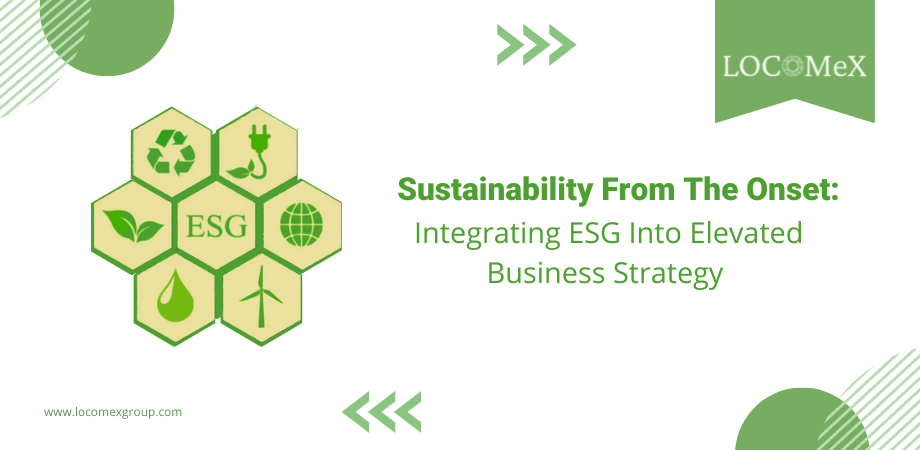Over the past two years, environmental, social, and governance issues have become more important in a company’s business model. ESG initiatives are based on the idea that non-financial factors have a meaningful impact on a company’s success and should be considered when making investment decisions. While some organizations have been integrating ESG into their company’s strategy, others are only starting to learn what the word ESG means for their particular industry.
It is observed that businesses that ignore ESG risks may be more susceptible to reputational harm, decreased sales, boycotts, and supply-chain problems (such as those related to COVID or climate change).
In contrast, integrating ESG strategies may result in enhanced financial performance, access to new and developing markets, increased resilience to market swings, and increased ability to draw in investment. It also increases staff attraction and retention, and, especially for smaller businesses, the chance to “stand out from the crowd” of their competitors.
So, in response to this growing emphasis on ESG and its possible advantages to business success, let’s discuss how to integrate ESG into business strategies.
What Are The 3 Essential Pillars Of ESG?
The term “sustainability” describes a multifaceted strategy that considers ESG issues. All these three pillars are essential for sustainable development to occur and give a competitive advantage.
The first pillar addresses environmental concerns. This pillar covers pollution reduction, energy efficiency, preservation of natural resources, reporting on greenhouse gas emissions, and waste minimization. It also entails controlling how land, water, and other resources are used to guarantee their continued availability. Additionally, they put solutions in a place like eco-friendly procedures and products to help lessen their ecological footprint.
The second pillar addresses social concerns. It takes into account how a company’s actions affect social issues. These include gender diversity and workplace equality, product safety, and liability concerns, employee health and safety, education and training, animal testing, supply chain transparency, human rights, and privacy concerns.
The last pillar is governance. A company’s internal operations and corporate behavior are discussed under this governance pillar. This pillar includes fostering economic expansion and development without sacrificing social or environmental concerns and establishes the standard for running a business. Good governance practices can boost earnings, reduce risks, and strengthen ties with stakeholders, including customers, employees, and other stakeholders, by ensuring that a business is operated ethically and with integrity.
LOCOMeX’s corporate sustainability software focuses on these three pillars so that organizations sustain long-term without harming the environment or using unethical practices.
Did you know Google has invested in clean energy technologies like wind and solar energy, which help minimize carbon emissions into the atmosphere while creating new jobs? It has also invested in developing electric vehicles as a strategy for carbon reduction.

What Is ESG Integration Strategy?
ESG integration strategy is the comprehensive and systematic integration of ESG priorities into investment analysis and decision-making. The sustainability management department needs to educate shareholders and internal and external stakeholders about ESG values and ethics.
Hence, ESG strategy must be rooted first in the corporate strategy of the organization’s mission, governance, and business strategies. Then, strategy development should be cascaded throughout the organization in areas like training, compensation, corporate finance, quality management, and research and development. Finally, it is layered into stakeholder activities like reporting, marketing, and collaborations. Hence, when it comes to communications, start with a prominent area of the company website that transparently explains where the company is in its ESG journey. Then, when identifying indicators to utilize for reporting annual progress on the company’s significant ESG issues, consider more rigorous reporting frameworks, such as the Global Reporting Initiative and the Value Reporting Foundation. According to Mckinsey, a decision-making checklist for ESG should include these five levers for a healthy cash flow: promoting growth, lowering expenses, limiting legal interventions, increasing employee productivity, and enhancing capital expenditure and investment. Also, global sustainable investment now exceeds $30 trillion, reflecting the parabolic growth of ESG-focused investments. Check out the corporate sustainability software from LOCOMeX to integrate ESG strategy into your company’s business units.What Is The Difference Between ESG and Sustainability?
ESG is a particular standard that has been established by legislators, investors, and ESG reporting organizations. Contrarily, ‘corporate sustainability‘ refers to actions that benefit a wide spectrum of stakeholders. However, the difference between ESG and sustainability lies in the reporting.
While an ESG report follows ESG criteria, a sustainability report is a periodic report published by companies aiming to communicate their environment and corporate social responsibility to various stakeholders.
The best ESG benchmarking tool from LOCOMeX provides ESG and scope 3 emissions reporting data that is auditable and generated at the project level across the supply and value chains.
How Does ESG Lead To Sustainability?
- Instead of focusing on sustainability, choose a sustainable business strategy. ESG shouldn’t be treated as an afterthought to more general company plans; rather, it should be completely integrated into corporate strategy.
- Establish an external advisory board with a range of functional expertise to help the organization find new opportunities and ensure compliance with best practices.
- Integrate ESG accountability into all areas of your company, including the CFO, CPO, CSO, hiring manager, quality manager, and others. Understanding the sustainable company strategy and incorporating it into choices are responsibilities that come with a position of authority.
- Consider incorporating sustainability into obvious, regular processes across all divisions to highlight its importance to the firm.
- The journey toward sustainability involves the entire organization. To encourage employees to contribute to sustainability, you need to engage them.
How Can LOCOMeX Help?
ESG issues have received more attention in recent years as investors look to engage in businesses dedicated to positively influencing society.
The AI-powered ESG and sustainability management software from LOCOMeX helps develop an ESG framework. Its action plan enables companies to set the vision, put the proper measures in place to manage material risks, and demonstrate the impact to the company’s stakeholders. Contact us here to learn more about how ESG can be useful in your company.




